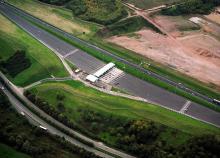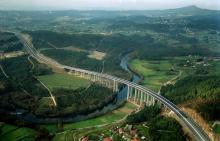Plenty of private money is seeking UK investment opportunities. The government and the infrastructure sector in general must make projects more attractive, writes David Barwell*
It is widely acknowledged that the UK faces mounting economic, environmental and social problems if the nation's infrastructure fails to meet present and future demands. Government estimates propose that almost €561 billion is required to bridge the infrastructure funding gap. As part of the response to this challenge, the UK's National Infrastructure Commission was established to provide expert advice to the government on the pressing infrastructure issues including ways to close the funding gap. The findings of the commission’s first National Infrastructure Assessment, issued in July, are now being debated (see box).
The assessment’s goals are ambitious. However, they reflect the infrastructure challenges that are already evident every day.
During this past summer alone there was a proliferation of headlines related to infrastructure strain and failures. Media stories included “recycling fraud” where plastics sent by people for recycling is instead sent to landfill. Extensive road congestion and unreliable rail networks frequently filled commuter bulletins. The hottest weather in the UK for decades was accompanied by water restrictions imposed across the country.
Private capital is an essential part of the solution.
Recommendations as set out in the National Infrastructure Assessment to improve delivery are ambitious - and they're expensive. But the report stresses that these things are not "an unaffordable wish list". The goals are designed to fit within the government's long-term funding guidelines for public investment in infrastructure.
Figure released in August by the
That said, the state simply can't finance all these changes and advancements alone. Developers are calling for greater access to private funding and the government wants this, too. In the next few years, the government's own National Infrastructure Plan states private capital should fund at least half of the cost of a €542 billion infrastructure pipeline to 2021.
At the same time, there are trillions of dollars of private capital, both foreign and domestic, searching for a home. There is US$120 trillion under management in global pension funds alone. Yet, despite infrastructure being critical to the growth and economic health of any country, the Paris-based OECD – Organisation for Economic Co-operation and Development - estimates that only a tiny percentage of this cash, just 1.6%, is invested in global infrastructure.
The UK's National Infrastructure Commission agrees that "financing itself is not in short supply. However, state financing institutions can help to encourage private investment and catalyse activity."
It appears that everybody wants the same thing. The government needs to drive more private cash into infrastructure projects and private investors wish to invest. So why isn't it happening?
Plans, commissions, reviews and assessments are all critical to working out what needs to be done. But if the government is to attract private investment, it needs to turn these visions into action - now.
Meanwhile, as we wait for the government to respond to the National Infrastructure Assessment, there are six steps that could be taken to move forward.
Six steps
Step one is to ensure that UK infrastructure is vigorously promoted.
Private investors are not necessarily infrastructure experts, nor connected and well-versed in the unique features of the UK infrastructure sector. For investors new to the UK, there is scant information available on the country's infrastructure project pipeline; just 220 words on the government's capital investment page.
New types of projects are emerging which will need financing in the near future. For example, one assessment recommendation is that government should encourage commercial investors to finance a nationwide electric vehicle charge point network.
It's an exciting investment opportunity which didn't exist a few years ago. However, such infrastructure projects die without government support and attention. Vocal government endorsement of infrastructure as a sector full of investment opportunities is vital.
There are exceptions of course. The proposed Heathrow Southern Rail link, for example, is an opportunity identified by the private sector that will be privately financed, including investment in part from AECOM. This will be one of the first projects under government plans to invite third parties - such as local authorities and private-sector companies - to invest in the rail network, alongside the €53 billion the government is planning to spend over the next five years.
Data, data, data
Step two should be to provide the data the private sector needs to invest with confidence.
A common criticism of infrastructure investment is that it is risky and unpredictable: Toll roads don't always perform as expected; construction timelines overrun; project costs can run far higher than forecast. Collecting and making readily available accurate, up-to-date data on the costs and performance of UK infrastructure projects makes for better decision making and builds trust in the sector as a place to house capital.
Providing private investors with data matters because they need to be presented with fully-formed, fleshed-out investment opportunities. Investors want to know that they're committing to projects, programmes and assets with characteristics that are already well understood. ROI – return on investment - is king.
Investors will not be prepared to rely on estimates and old information when assessing the costs and benefits of projects. Providing data on the financial performance and costs of UK infrastructure assets gives private investors the ability to predict and project long-term revenue streams.
The government needs to improve communication between the public and private sector and ramp up data collection to access capital providers that previously wouldn't have been knowledgeable and confident enough to invest.
This is about taking a pragmatic, data-and-results-led approach to offering investment opportunities to the private sector. The opportunity is for government and the private sector to engage at the design stage in order that investors have the opportunity for early input into a project and that both parties can share data.
Innovative financing
Step three is for the government to be open to creating and attracting new financing structures and institutions. This could be done by establishing programmes and institutions dedicated to infrastructure finance.
One such example is the Asian Infrastructure Investment Bank that was set up to support the building of infrastructure in the Asia-Pacific region. Another vehicle is that of value capture which is often used around new transportation hubs. This is where infrastructure investment enhances land values so that transportation and city landowners draw benefit from their investment for future spending including on schools, housing and public space.
The need for new ways to mobilise private capital is even more pressing as Britain prepares to leave the European Union. The EU's European Investment Bank has worked for decades to bring private capital into infrastructure projects - but the UK's membership of the bank could end post-Brexit. The NIA suggests a dedicated UK infrastructure finance institution needs to be created if this happens.
We already have evidence that government is capable of this kind of work. In the renewable energy sector, the Green Investment Group was originated by the state in 2012. It is now owned by private bank Macquarie, the world's largest infrastructure asset manager, and has invested €3.8 billion into UK clean energy projects. It's an example of how the government has the ability to create infrastructure-supporting schemes and institutions which can ultimately be handed over to, and financed by, the private sector.
The private sector can also provide the ideas. Indeed, it is well placed to innovate and leverage lessons from elsewhere, as with the aforementioned Heathrow Southern Rail link.
One recent positive step to encourage private sector ideas is the UK government's introduction of a “market-led proposals” initiative. This is a mechanism that provides a route for the private sector to propose infrastructure enhancement projects. The first submissions for rail projects were made this summer.
For these projects to proceed, industry needs those ideas to be rapidly appraised by government and shortlisted for suitability. The market-led proposals process is a first test of how attractive the government can make investment in the railways, making it clear that it is open for business and collaboration with the private sector.
The first National Infrastructure Assessment
The assessment by UK's National Infrastructure Commission gives a snapshot of some of the country’s most important infrastructure needs. Its seven recommendations – goals - set out a pathway for the UK's economic infrastructure:
• Nationwide full-fibre broadband by 2033
• Half of the UK's power provided by renewables by 2030
• Three-quarters of plastic packaging recycled by 2030
• Allocating €48 billion of stable, long-term transport funding for regional cities
• Preparing for 100% electric vehicle sales by 2030
• Ensuring resilience to extreme drought
• National standard of flood resilience for all communities by 2050
Matchmaking
Step four should be to match investors with the stage of an infrastructure project that would be most suitable for them in which to invest.
When developing projects, the government needs to investigate which private investors could potentially lend to a project - and crucially, at what stage.
From banks to funds, pension providers to individual businesses, private sources of capital come in many forms. Each will have a different risk appetite and investment timeline. If appropriate projects are marketed to private investors at the right time and at the right stage for their requirements, then the chances of them investing should increase. This requires the government and private sector to agree on a common aim that will satisfy governmental need and private sector aspiration on a return from these investments.
As an example, the risk appetite of an international pension fund new to investing in UK infrastructure will be very different from that of a dedicated infrastructure fund listed on the London Stock Exchange. A pension fund will want steady, predictable, long-dated returns to match its liabilities. These are the kind of returns that can be generated by infrastructure which is already operational and performing well.
Meanwhile, a listed fund, already familiar with the market, will likely have a far higher tolerance for uncertainty. It may be willing to invest at the riskier construction phase of a project in exchange for higher returns.
Party politics
Political bias is an issue which has stunted the growth of the sector for decades. The National Infrastructure Commission was set up, in its own words, “to address the lack of a long-term infrastructure strategy, soiled decision-making in infrastructure sectors, fragile political consensus and short-termism”.
Step five should, therefore, clearly be the fostering of better communication between the public and private sectors, beyond party politics. Each has something to offer the other: the government can present state-backed infrastructure projects in which to invest and the private sector can find a home for the capital it needs to deploy. This would generate a win-win situation where much-needed infrastructure gets delivered free from huge expense to the tax-payer.
If the private investment community is being asked to make long-term, multibillion dollar investment, the government in return needs to offer long-term guarantees and protection to these potential investors.
Happily, positive change is already underway. The government has been attempting to move rail enhancement investment out of its standard five-year cycle. Similar approaches can be applied to other types of infrastructure, too. The process for assessing rail enhancement investment is the same whether publicly or privately funded: the Rail Network Enhancements Pipeline. This is a strong statement that both forms of funding will be assessed equally.
Speak up
A final, sixth step, is to speak louder about the public benefits of infrastructure investment.
We've already touched on the lack of information available to the private investment community on the benefits of infrastructure spending. The same issue exists for the public. Getting citizens to support infrastructure investment is essential to getting projects off the ground, particularly in the UK, where projects are frequently blocked or slowed by local opposition.
Public consultation on infrastructure schemes is complex and detailed. It takes time for members of the public to assess a project. That tends to mean people who are retired from the daily working world have more time to scrutinise a project. A typical project timeline means they see no benefit - only impact. That generates opposition.
Meanwhile, the young generation - the real beneficiaries of infrastructure - are often less engaged in these consultations. There is a challenge to improve the engagement of the citizens who will see little impact and yet will realise all the benefits.
Can do better
The government could do more to promote the positives of new and improved infrastructure as a path to economic growth, community cohesion and a better standard of living for large numbers of people. Time and again we have seen that infrastructure investment unlocks other investment, particularly housing. Developers cannot deliver large-scale community projects - in some cases entire new towns - without strategic investment in transport, utilities and community infrastructure.
The government should also include and recognise citizens as vital contributors to the solutions. One of the National Infrastructure Assessment's key recommendations is to ramp up materials and food-waste recycling: it will be necessary for the public as well as industry to move this forward.
Essentially, any major public and private spending on infrastructure needs to be explained in terms of the way it will help people live better and drive economic and social growth.







